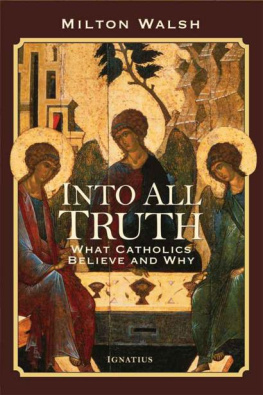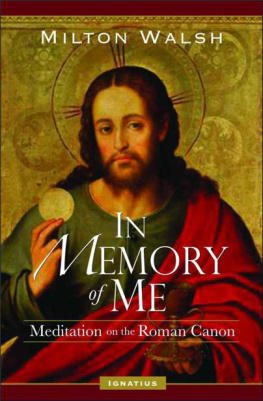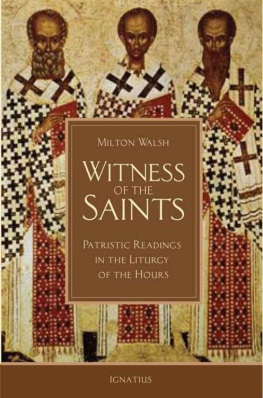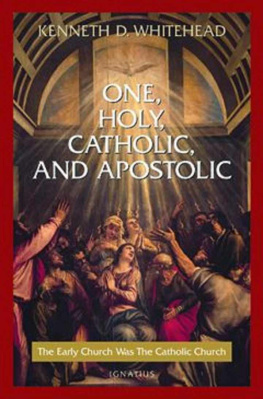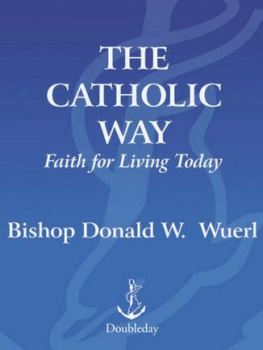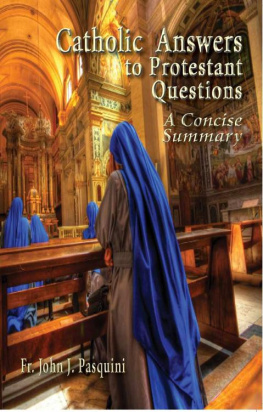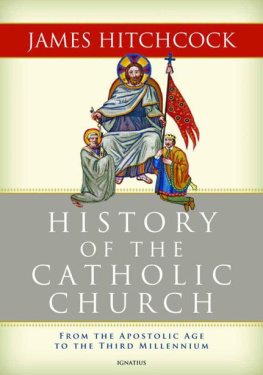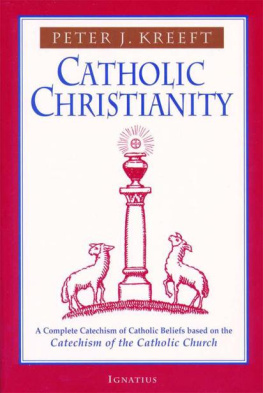MILTON WALSH
INTO ALL TRUTH
INTO ALL TRUTH
What Catholics Believeand Why
IGNATIUS PRESS SAN FRANCISCO
Nihil Obstat: Reverend Monsignor J. Warren Holleran Censor Librorum
Imprimatur: + Most Reverend Salvatore Cordileone Archbishop of San Francisco November 28, 2012
Unless otherwise noted, Scripture quotations (except those within citations) have been taken from the Revised Standard Version of the Holy Bible, Second Catholic Edition, 2006. The Revised Standard Version of the Holy Bible: the Old Testament, 1952, 2006; the Apocrypha, 1957, 2006; the New Testament, 1946, 2006; the Catholic Edition of the Old Testament, incorporating the Apocrypha, 1966, 2006, the Catholic Edition of the New Testament, 1965, 2006 by the Division of Christian Education of the National Council of the Churches of Christ in the United States of America. All rights reserved.
Excerpts from the Catechism of the Catholic Church , second edition, copyright 2000, Libreria Editrice Vaticana-United States Conference of Catholic Bishops, Washington, D. C. Used with permission. All rights reserved.
Cover art Icon of the Trinity by Andrei Rublev (1360c. 1430) Rublev Museum, Moscow, Russia Scala / Art Resource, New York
Cover design by Riz Boncan Marsella
2013 by Ignatius Press, San Francisco All rights reserved ISBN 978-1-58617-486-6 Library of Congress Control Number 2012945578 Printed in the United States of America
A Word of Thanks, and Dedication
For two thousand years, the Holy Spirit has guided the community of believers into all truth, writing a living Gospel in the faith of the Catholic Church. I would like to dedicate this work to three communities of learning who taught me that Gospel, but before doing so I should acknowledge some individuals who assisted me in this project. I am grateful to several theologians who reviewed different sections of this book and made very helpful corrections and suggestions: Msgr. Dennis Mikulanis; Fr. Gerald OCollins, S. J.; Fr. Francis Sullivan, S. J.; and Fr. Ronald Witherup, S. S. Mr. Anthony Dolan offered valuable assistance regarding the style and organization of the material presented here.
Three people deserve special thanks because they read and re-read each chapter of Into All Truth and by their questions and observations helped a great deal: Sr. Mary Edel, O. C. D.; Mr. David Kent; and Mr. Alexander Stepanov.
I have been greatly blessed in the Catholic education I have received, and I gratefully dedicate this book to three communities:
The Sisters of the Holy Names of Jesus and Mary at Saint Cecilia School, San Francisco
The Sulpician Fathers at Saint Josephs College and Saint Patricks Seminary
The Jesuit community at the Gregorian University and their lay and religious colleagues. By word and example, they have been a living Gospel for me, and for countless others.
When the Spirit of truth comes, he will guide you into all the truth; for he will not speak on his own authority, but whatever he hears he will speak, and he will declare to you the things that are to come. He will glorify me, for he will take what is mine and declare it to you. All that the Father has is mine; therefore I said that he will take what is mine and declare it to you.
John 16:13-15
Contents
The Resurrection of Jesus
Christs Redemptive Death
The Incarnation of the Son of God
The Most Holy Trinity
The Church
The Pope and the Bishops
Sacred Scripture
The Life of Grace
The Sacraments
The Holy Eucharist
The Communion of Saints
Mary, Virgin and Mother
Marys Origin and Destiny
Life Everlasting
Introduction
When Pope John Paul II visited the United States in 1987, I spent about a week at a local television station providing background information to the newscasters covering the papal visit. Toward the end of the week, one of them asked me, Why does the Catholic Church have such a hang-up about sex? For several days we had been continually discussing several hot button topics: birth control, abortion, divorce, homosexuality, celibacy, and the ordination of women. I pointed out that these were the issues she had brought up, and I mentioned several subjects we had not talked about: our beliefs, our music, our art, our philosophy, our schools, our social services, our literature, and our saints.
Purpose
This book is about the first item on my list, and the most fundamental: our beliefs. What do we believe as Catholics, and why? I am writing first for my fellow Catholics. Over the past fifty years, we have given much attention to Church structures, liturgical changes, and moral issues. Important as these matters are, what we believe isor should bemore basic. But how can we deepen our understanding of our Catholic faith? For most of us, our only adult education takes place at the Sunday homily. While it is appropriate for a preacher to speak about doctrine, the homily is not the occasion for an in-depth presentation of the faith. For this, there is no substitute for personal study You may have grown up before the Second Vatican Council, and wonder what the connection is between what you learned then and what the Church teaches now; you may be younger and have never received much instruction on the Creed. I hope that this book will help you learn more about the basic beliefs we profess. I am writing for the general reader and will try to avoid theological terms, except where these are necessary to express the nuances of Catholic faith.
I also have an ecumenical purpose in mind. Sometimes non-Catholics reject what they mistakenly believe to be Catholic teaching; if this book helps dispel misunderstandings, it may further, in some small way, the cause of Christian unity. There are also Catholic doctrines that other Christians understand correctly, but do not accept. If we are interested in fostering unity among the followers of Christ, these differences cannot be papered over. I will note where Catholic doctrines create difficulties for other Christians, but my aim is exposition, not controversy. I am guided by the advice given in the First Letter of Saint Peter: Always be prepared to make a defense to any one who calls you to account for the hope that is in you, yet do it with gentleness and reverence (1 Pet 3:15).
The most important common ground Christians share is the Bible. Throughout this book, I will refer frequently to the Scriptures, citing the Revised Standard Version of the Bible, which is itself a good example of ecumenical cooperation. These are the principal sources of authoritative Church teaching; they provide many biblical citations in their presentation of the Catholic faith; and they are readily accessible to everyone. Appendix B at the end gives suggestions on how to use the Catechism and references to appropriate paragraphs for each chapter of this book. There is also a study guide that relies heavily on the Catechism . This study guide is available online at www.intoalltruthbook.com and is designed to be used in RCIA, in the classroom, or by adult study groups in a parish.
Structure
The plan of this book is very simple. Part One brings us into the heart of the Christian faith, the mystery of the Trinity, beginning with the Resurrection. Why begin there? That extraordinary event prompted Jesus followers to reflect on his mission and identity, which in turn led them to see the one God as an eternal communion of Father, Son, and Holy Spirit. The Good News is that we are invited to enter into that communion of love, so Part Two shows how other Catholic beliefs are rooted in the mystery of the Trinity. In conclusion, I offer a brief reflection on the role played by the Roman Catholic Church in handing on the Gospel over the past two thousand years.

